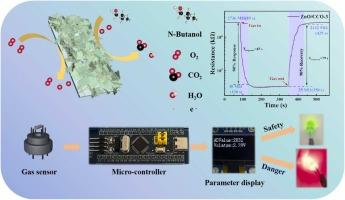Enhanced n-butanol Gas Sensors Based on ZnO/CuCo2O4 Heterojunction: Materials Synthesis, Sensing Performance, and Mechanism Study
IF 6.3
2区 材料科学
Q2 CHEMISTRY, PHYSICAL
引用次数: 0
Abstract
This work presents the development of a ZnO/CuCo2O4 nanocomposites gas sensor for the detection of n-butanol, a hazardous volatile organic compound. The ZnO/CuCo2O4 nanocomposites were synthesized via hydrothermal method and characterized using XRD, XPS, SEM, BET, and TEM. The gas sensor exhibited remarkable performance for n-butanol detection, with a high response value of 78 at 100 ppm and a linear concentration response range from 20 to 100 ppm. The sensor also demonstrated fast response and recovery times of 45 s and 79 s, respectively. Meanwhile, an in-depth analysis was conducted on the gas-sensing mechanism. Using Density Functional Theory (DFT) calculations, the adsorption process and electron transfer of n-butanol gas molecules on the ZnO/CuCo2O4 surface were simulated, confirming the gas-sensing adsorption process of the n-butanol gas sensor. In summary, the ZnO/CuCo2O4 heterojunction enhanced the gas sensing properties, offering a promising solution for real-time monitoring of n-butanol in environmental, industrial, and safety applications. The research highlights the potential of binary metal oxide nanocomposites in improving gas-sensing performance and offers a novel approach for detecting hazardous VOCs.

基于ZnO/CuCo2O4异质结的增强正丁醇气体传感器:材料合成、传感性能及机理研究
本文介绍了一种用于检测有害挥发性有机化合物正丁醇的ZnO/CuCo2O4纳米复合气体传感器的开发。采用水热法制备了ZnO/CuCo2O4纳米复合材料,并用XRD、XPS、SEM、BET和TEM对其进行了表征。该气体传感器在正丁醇检测中表现出优异的性能,在100 ppm下的响应值高达78,浓度响应范围为20 ~ 100 ppm。该传感器的响应时间和恢复时间分别为45秒和79秒。同时,对气敏机理进行了深入分析。利用密度泛函理论(DFT)计算,模拟了正丁醇气体分子在ZnO/CuCo2O4表面的吸附过程和电子转移,证实了正丁醇气体传感器的气敏吸附过程。综上所述,ZnO/CuCo2O4异质结增强了气体传感性能,为环境、工业和安全应用中的正丁醇实时监测提供了一个有前景的解决方案。该研究强调了二元金属氧化物纳米复合材料在提高气敏性能方面的潜力,并为检测有害挥发性有机化合物提供了一种新的方法。
本文章由计算机程序翻译,如有差异,请以英文原文为准。
求助全文
约1分钟内获得全文
求助全文
来源期刊

Journal of Alloys and Compounds
工程技术-材料科学:综合
CiteScore
11.10
自引率
14.50%
发文量
5146
审稿时长
67 days
期刊介绍:
The Journal of Alloys and Compounds is intended to serve as an international medium for the publication of work on solid materials comprising compounds as well as alloys. Its great strength lies in the diversity of discipline which it encompasses, drawing together results from materials science, solid-state chemistry and physics.
 求助内容:
求助内容: 应助结果提醒方式:
应助结果提醒方式:


